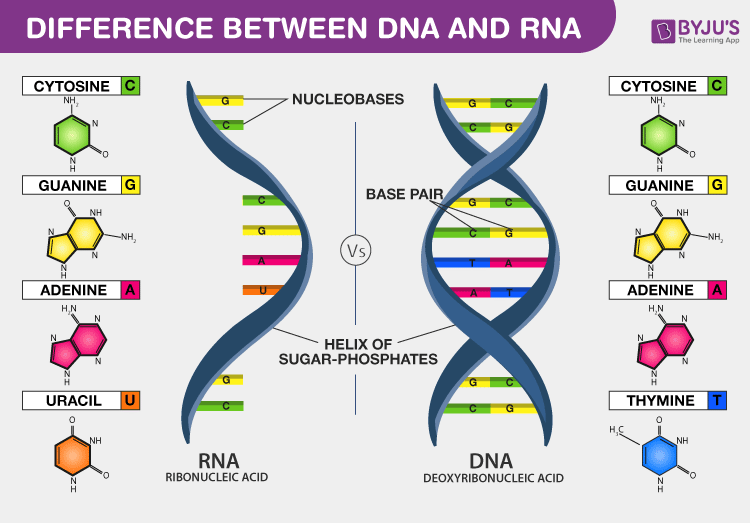Life on earth is very diverse, from single-celled protozoans to complex multicellular plants and animals. But at the molecular level, all life is fundamentally made up of the same building blocks – DNA and RNA. One of the primary differences between DNA and RNA is that DNA is double-stranded while RNA is single-stranded.
Table of Contents
Read on to explore the DNA and RNA differences in detail.

Differences Between DNA and RNA
Following are the important differences between DNA and RNA:

DNA and RNA Difference
| DNA (Deoxyribonucleic acid) | RNA (Ribonucleic acid) |
| Definition | |
| It is a long polymer. It has a deoxyribose and phosphate backbone having four distinct bases: thymine, adenine, cytosine and guanine. | Is a polymer with a ribose and phosphate backbone with four varying bases: uracil, cytosine, adenine and guanine. |
| Location | |
| It is located in the nucleus of a cell and in the mitochondria. | It is found in the cytoplasm, nucleus and in the ribosome. |
| Sugar portion | |
| It has 2-deoxyribose. | It has Ribose. |
| Function | |
| The function of DNA is the transmission of genetic information. It acts as a medium for long-term storage. | RNA is critical for the transmission of the genetic code that is necessary for protein creation from the nucleus to the ribosome. |
| Predominant Structure | |
| DNA is a double-stranded molecule that has a long chain of nucleotides. | RNA is a single-stranded molecule which has a shorter chain of nucleotides. |
| Propagation | |
| DNA replicates on its own, it is self-replicating. | RNA does not replicate on its own. It is synthesized from DNA when required. |
| Nitrogenous Bases and Pairing | |
| The base pairing is as follows: GC (Guanine pairs with Cytosine) A-T (Adenine pairs with Thymine). | The base pairing is as follows: GC (Guanine pairs with Cytosine) A-U (Adenine pairs with Uracil). |
DNA
In cells, DNA (Deoxyribonucleic acid) is the nucleic acid that functions as the original blueprint for the synthesis of proteins. DNA contains the sugar deoxyribose, phosphates and a unique sequence of the nitrogenous bases adenine (A), guanine (G), cytosine (C) and thymine (T).
Brief Insight into the Structure and Composition of DNA
The DNA molecules contain instructions a living entity requires to grow, develop and reproduce. These instructions are present inside each cell and are inherited from the parents to their offspring.
It is made up of nucleotides which contain a nitrogenous group, a phosphate group, and a sugar group. The order of the nitrogenous bases – thymine(T), guanine(G), cytosine(C), and adenine(A), is crucial in determining the genetic code.
Genes are formed by the order of the nitrogenous bases present in the DNA which is crucial for protein synthesis. RNA is another nucleic acid that translates genetic information into proteins from DNA.
The nucleotides are linked together for the formation of two long strands which spiral to produce a structure known as the double-helix which resembles that of a ladder wherein the sugar and phosphate molecules form the sides while the rungs are formed by the bases.
The bases located on one strand pair up with the bases on the other strand, as in – guanine pairs with cytosine and adenine pairs with thymine.
The DNA molecules are extremely long and hence without the right packaging, they cannot fit into cells. Thus, DNA is tightly coiled to produce formations referred to as chromosomes. Every chromosome has a single DNA molecule. In humans, there are 23 pairs of chromosomes that are present within the nucleus of the cells.
Main article: DNA Structure
Types Of DNA
- A-DNA: It is found at a relative humidity of 75%. In an environment where there is a higher salt concentration or ionic concentrations, such as K+, Na+, Cs+ or in a state of dehydration it endures in a form that contains 11 nucleotide pairs with a rise of 2.56Å vertically per base pair. It has the broadest helical diameter amongst all DNA forms – 23Å DNA which is a typical helix that is right-handed with a rotation of 32.70 per base pair.
- B-DNA: The most common form, present in most DNA at neutral pH and physiological salt concentrations, is B-form. It has 10 base pairs per turn from the helix axis. There is a distance of 3.4Å with a helical diameter of 20Å. Watson-Crick’s double helix model is defined as a B-form of DNA.
- C-DNA: It is observed at a relative humidity of 66% and in the occupancy of a few ions such as Lithium(Li+). It closely has 9.33 base pairs for every turn. The diameter of the helix is about 19Å and the vertical rise for every base pair for the right-handed helix is 3.320.
- D-DNA: It is observed rarely as an extreme variant. The 8 base pairs are titled negatively from the helix axis with an axial rise of about 3.03Å
- Z-DNA: It is found in an environment with a very high salt concentration. Unlike the A, B, and C types of DNA, it is a left-handed helical structure. The backbone is arranged in a zig-zag pattern formed by the sugar-phosphate linkage wherein the recurrent monomer is the dinucleotide in contrast to the mononucleotide, which is observed in alternate forms.
RNA
Ribonucleic acid (RNA) is a nucleic acid which is directly involved in protein synthesis. Ribonucleic acid is an important nucleotide with long chains of nucleic acid present in all living cells. Its main role is to act as a messenger conveying instructions from DNA for controlling protein synthesis.
RNA contains the sugar ribose, phosphates, and the nitrogenous bases adenine (A), guanine (G), cytosine (C), and uracil (U). DNA and RNA share the nitrogenous bases A, G, and C. Thymine is usually only present in DNA and uracil is usually only present in RNA.
Types Of RNA
Only some of the genes in cells are expressed into RNA. The following are the types of RNA wherein each type is encoded by its own type of gene:
- tRNA– The transfer RNA or the tRNA carries amino acids to ribosomes while translation
- mRNA – The messenger RNA or the mRNA encodes amino acid sequences of a polypeptide
- rRNA – The ribosomal RNA or the rRNA produces ribosomes with the ribosomal proteins that are organelles responsible for the translation of the mRNA.
- snRNA – The small nuclear RNA forms the complexes along with proteins which are utilized in RNA processing in the eukaryotes.
Explore More: Structure of RNA
Role Of Protein
To place these ideas in the proper context, remember that some proteins are enzymes that aid cells by catalyzing chemical reactions. These chemical reactions occur after the enzyme binds its substrate at the enzyme’s active site. The enzyme’s active site matches the substrate molecule in size, shape and chemical properties.
The size, shape, and chemical properties of an enzyme’s active site are due to the combination of the enzyme’s amino acids, which are the individual subunits of the enzyme. For the cell to reliably make an enzyme, the cell must be able to control the placement of amino acids in a protein during the synthesis of enzymes.
Proteins play a critical role in how cells successfully meet the challenges of living. Cells use proteins to maintain their shape and to speed up important chemical reactions such as photosynthesis and respiration.
A cell will not live long if it cannot reliably create the proteins that it needs for survival.
More to Read: Proteins
To learn more about the difference between DNA and RNA, visit BYJU’S Biology.
Further Reading
Frequently Asked Questions
What is the composition of DNA and RNA?
DNA and RNA are nearly identical polymers of nucleotides, except for the base pairs. DNA contains thymine while the same is substituted with uracil in RNA.
Where are DNA and RNA found?
DNA is located in the nucleus of a cell and in the mitochondria. Meanwhile, RNA is found in the cytoplasm, nucleus, and also in ribosomes.
How does propagation occur in DNA and RNA?
DNA is capable of self-replication but RNA cannot self-replicate instead, it is synthesized from DNA (DNA transcription) when required.
What is the similarity between DNA and RNA?
Three out of the four nitrogenous bases in DNA and RNA are the same (cytosine, adenine, guanine). They both possess a phosphate backbone to which the bases attach.
Why is DNA a better genetic material than RNA?
The deoxyribose sugar of DNA contains one less oxygen-containing hydroxyl group. DNA is a more stable nucleic acid. RNA, on the other hand, contains ribose sugar and is more reactive than DNA. Therefore, DNA is a better genetic material than RNA.
Which plant hormone is helpful in making RNA and protein?
The plant hormone cytokinin helps in the synthesis of protein and RNA. It functions naturally in conjunction with auxins. In the presence of auxins, it promotes cell division and development. It enables awakening seeds from their dormancy.


nice
Nice
wow its perfect
It is easy to understand, even for non-biology people like me. It really helps. Thank you so much.
Great!
really good info for people interested in bio and other sub’s
If RNA cannot replicate itself, then how does COVID 19 reproduce itself?
Viral RNA needs certain cellular components which it can obtain only from its host cell, which in the case of COVID 19, is humans.
simple n good information
Explained in very simple language easy to understand the basics of DNA and RNA
Very helpful.
1: Why RNA is considered as a carrier of information?
2: Why DNA is considered as a hereditary material?
1. RNA is considered the carrier of information because it translates the genetic information present in the DNA to proteins.
2. DNA is considered the genetic material as it is inherited from parents to offsprings.
Thank you, very helpful
thank you, very helpful
Thank you so much, it helps me.
Thanks, I was actually looking for it, GREAT
It is very useful. But also I need detail definition for DNA and RNA.
Thank you. To understand DNA in detail, refer to this link – https://byjus.com/biology/dna-structure/. More about the structure of RNA can be learnt from this link – https://byjus.com/biology/structure-of-rna/